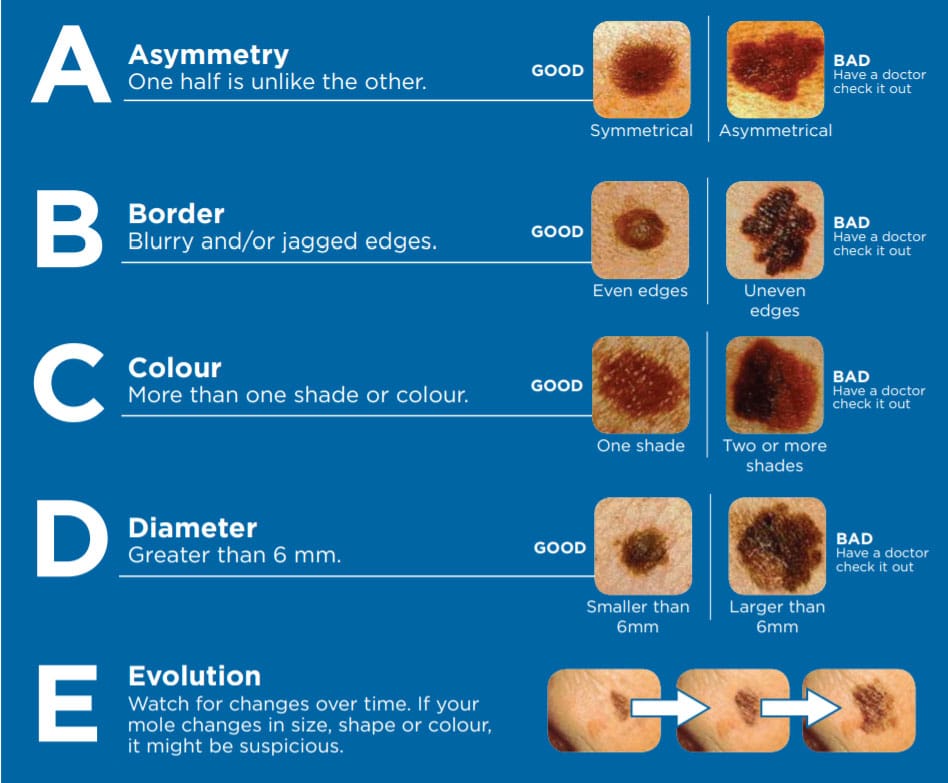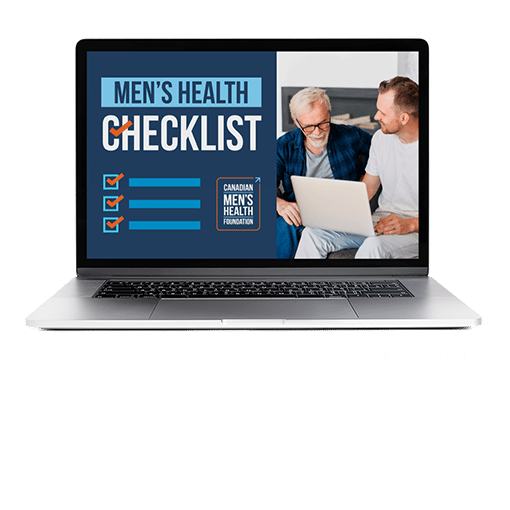All guys check themselves from time to time. It’s better to glance at the rear-view mirror than it is to have food stuck on your face all day! Runaway crumbs aren’t the only things guys can catch by checking themselves. It takes just a few minutes to check your body for early signs of a wide range of health problems.
Why is it important to do self-exams? Because the earlier you catch a health problem, the better the chances of avoiding serious consequences down the road. So let’s check out 8 easy self-exams for men:
Testicular cancer self-exams
How long: About a minute
How often: Once a month
When to do it: Just after you’ve had a bath or shower when the muscles in your scrotum are relaxed.
When not to do it: After swimming in cold water. Shrinkage!
How to do it:
Step 1: Stand in front of the mirror naked and look for any swelling on the skin of your scrotum.
Step 2: Feel the size and weight of each testicle. It is common for one to be slightly larger or hang lower than the other.
Step 3: Individually roll each testicle between your thumb and finger. It should feel smooth. It’s normal to feel a soft, tender tube towards the back. You shouldn’t feel any pain during these checks.
Signs of trouble: Lumps, growths, or unusual tenderness.
Skin cancer self-exams
How long: About five minutes
How often: Once a month
When to do it: Whenever you have five spare minutes in your birthday suit.
When not to do it: In the break room at lunch (unless you work at a nudist resort).
How to do it:
Step 1: Examine your body front and back in the mirror, then your right and left sides with arms raised.
Step 2: Bend your elbows and look carefully at your forearms, upper underarms and palms.
Step 3: Look at the backs of your legs and feet, the spaces between your toes, and the soles of your feet.
Step 4: Use a hand mirror to examine the back of your neck and scalp. Part your hair for a closer look.
Step 5: Finally, check your back and buttocks with a hand mirror.
Pro tip: Download the free Miiskin app from the Apple App Store and Google Play Store to track changes to your skin through your smartphone.
Signs of trouble: The Canadian Skin Cancer Foundation has this early prevention guide:

Dental self-exam
How long: Less than two minutes
How often: Weekly
When to do it: After brushing your teeth and rinsing thoroughly .
When not to do it: While proposing to your significant other.
How to do it: Pull your lower lip down, and your upper lip up and fully examine all of the tissue and gums.
Signs of trouble: Gum disease could be an issue if your gums are red, shiny, puffy, sore or sensitive; if there’s bleeding when you brush or floss; or if you have bad breath that won’t go away. Signs of oral cancer include bleeding or open sores that don’t heal, white or red patches on your gums, numbness or tingling, small lumps and thickening on the sides or bottom of your tongue, the floor or roof of your mouth, the inside of your cheeks, or on your gums.
Resting heart rate self-exam
How long: One minute
How often: Monthly
When to do it: Whenever you can, find 10 minutes to sit in a quiet place free from distractions. Pro tip: A parked car is a great option.
When not to do it: While watching any of the “Friday the 13th” horror movies.
How to do it
Step 1: Take a seat and chill out for about 10 minutes.
Step 2: Hold your hands out in front of you with your elbows bent and your palms facing up.
Step 3: Gently place two fingers of one hand on the wrist of the other hand and feel for your pulse, which is the rate at which your heart beats. If you can’t feel your pulse in this spot, try the sides of your neck, temple area, groin, behind the knee, or top of your foot.
Step 4: Count the beats of your pulse for 30 seconds, then double the result to get the number of beats per minute (BPM).
Signs of trouble: Anything below 60 or above 100 BPM (60-100 BPM is the normal resting heart rate for adults).
Blood pressure self-exam
How long: Six minutes or so
How often: Every 2-5 years if you’re under 40 years old, every year if you’re 40-plus.
When to do it: Any time you’re in a drug store that has a free blood pressure machine.
When not to do it: While riding a roller-coaster (even a kiddie one).
How to do it
Step 1: Sit down and relax for about five minutes.
Step 2: Wrap the cuff around your arm as indicated.
Step 3: Push a button to inflate the cuff. It then deflates at the rate needed for an accurate test.
Signs of trouble: Normal blood pressure for men is 120-over-80 or thereabouts. When it stays above 140-over-90, it can cause strokes, heart attacks, and heart and kidney failure. To learn more about what those numbers mean, check out this article on optimal blood pressure for men.
Waist circumference self-check
How long: Less than a minute
How often: Once a year
When to do it: Any time you can go shirtless — and that includes home games of your favourite team! Just try not to get body paint on the tape measure (see below).
When not to do it: At the opera – unless it’s a rock opera, then go right ahead!
How to do it: Wrap a tape measure around your body at the top of your hip bone. This is usually at the level of your belly button.
Signs of trouble: Men with waist circumferences greater than 102 centimetres/40 inches are at increased risk of type 2 diabetes, high cholesterol, high blood pressure, and cardiovascular disease.
Check out these awesome blog posts that cover easy ways to get active, eat healthier, and drink less alcohol.
Body mass index (BMI) self-exam
How long: Less than a minute
How often: Once a year
When to do it: Unless you’re a math whiz, any time you have access to a calculator or the Internet.
When not to do it: During an axe-throwing competition
How to do it: The formula for calculating BMI is your weight in kilograms divided by your height in meters squared. For example, a guy who weighs 80 kilograms and is 1.8 metres tall has a BMI of 24.7. (That’s 80 divided by 3.24, which is 1.8 x 1.8.)
Pro tip: This free online calculator gives you your BMI faster than a hang-glider in a hurricane and even converts pounds to kilos and feet/inches to metres.
Signs of trouble: Guys with BMIs of 30 and up are at increased risk of heart attack, colon and prostate cancer, low testosterone and erectile dysfunction, and type 2 diabetes.
Check out these helpful blog posts for simple tips to get active, eat healthier, and drink less alcohol.
Breast cancer self-exam
Wait…what? Do guys need to check for breast cancer? While less than 1 percent of all breast cancers occur in men, researchers estimate that 270 new cases will be diagnosed in Canada in 2022 and that 55 men will die from the disease. So the short answer is YES. Guys DO need to check themselves for this!
How long: Less than two minutes
How often: Once a month
When to do it: During or right after a warm shower or bath, as this relaxes and smoothes the skin making the exam easier to perform.
When not to do it: During or immediately after a polar bear dip.
How to do it
Step 1: With the fingers of your right hand flat against your left breast, press firmly in small, clockwise circles.
Step 2: Start at the outermost top edge of your breast and spiral towards the nipple.
Step 3: Feel for hard lumps or bumps in your breast. Be certain to cover all parts of your breast.
Step 4: Gently squeeze both nipples and look for any discharge.
Step 5: Repeat the process with your left hand and right breast.
Step 6: Look carefully for changes in the size and shape of each breast.
Signs of trouble: Hard lumps or bumps, as well as changes in the size and shape of each breast, such as puckering, dimpling, or changes in skin texture.
Do you know of other self-exams you’ve found to be useful? Share with us in the comments below.

Men’s Health Checklist
Find out what tests you need and when. Stay up-to-date on screening, exams and vaccines, and assess how stress impacts your mental health.




Let’s Talk!
Did you enjoy this article? Let us know in the comments.
0 Comments